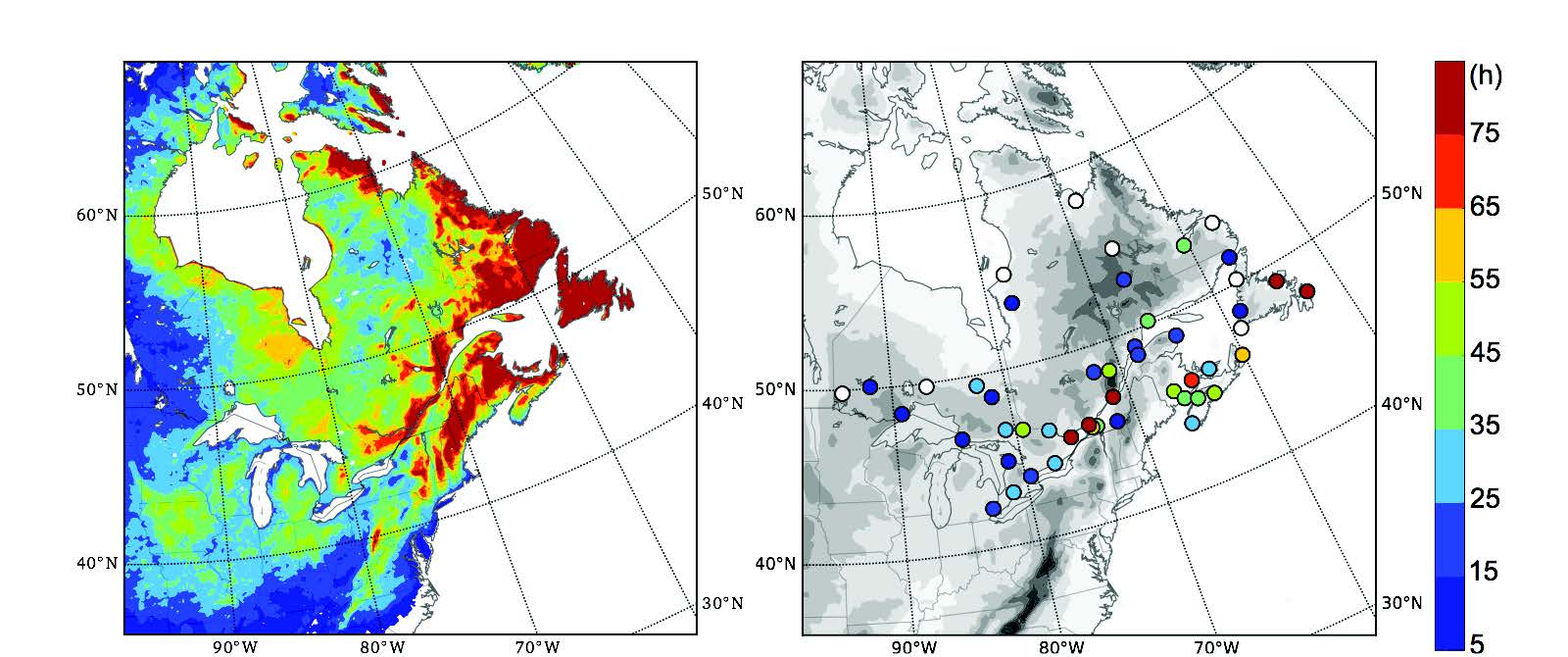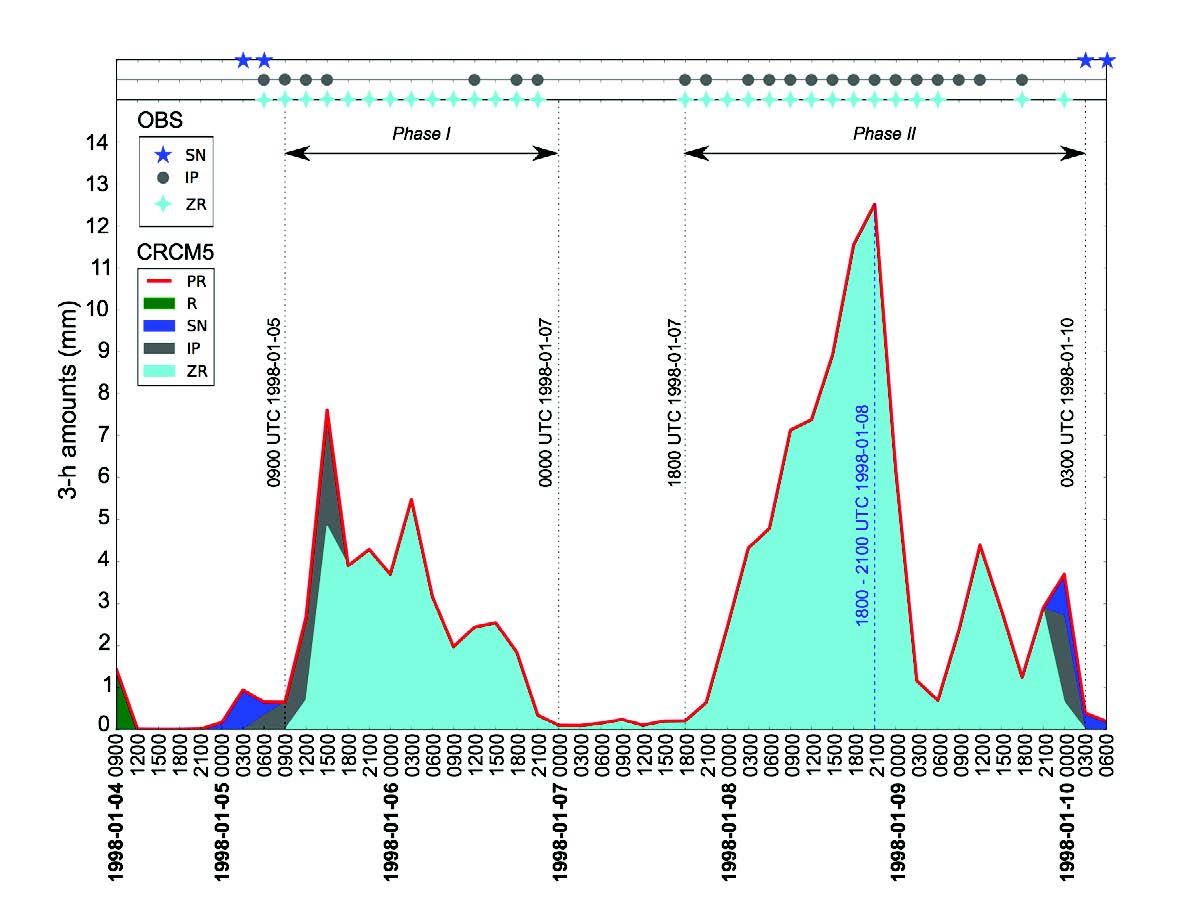Feasability study and operationalization of the diagnostic simulation of freezing rain by the CRCM5
The success of this project has meant that freezing rain and ice pellets are now among the standard outputs available from the CRCM5 climate projections produced by Ouranos. The development of a more complex microphysics model, adapted to the computational cost of a climate model, is also in the works for the years ahead.
Project details
Principal(s) investigator(s)



Context
The CNRCWP network (2013-2018), led by Professor Laxmi Sushama of UQAM, is working on the development of the Canadian Regional Climate Model, version 5 (CRCM5), with a focus on studying the added value provided by regional models by virtue of the finer resolution they offer compared to global models. Because freezing rain is a physical phenomenon that is dependent on fine scale conditions, it is a prime candidate for this type of study. The objective of the present project is to assess the ability of the CRCM5 to produce freezing rain using two diagnostic approaches that do not require a computationally expensive microphysics model to produce climate simulations. The first approach uses a diagnostic module implemented in the CRCM5 (Bourgouin 2000), while the second is based on a posteriori calculation (Cantin and Bachand 1993) to diagnose freezing rain from archived data related to other variables. The possibilities for immediate application of this work are of great interest to Ouranos, which has adopted the CRCM5 for use in its climate change impact and adaptation projects. Ouranos is working with CNRCWP to ensure knowledge transfer and implementation within its Climate Simulation and Analysis group.
Objective(s)
-
Assess the potential of the two diagnostic approaches to simulate freezing rain from climate simulations produced by the CRCM5.
-
Ensure science and technology transfer of methodologies for the simulation of freezing rain developed in the CNRCWP network to Ouranos.
Methodology
-
Assess the ability of the CRCM5 to simulate freezing rain using the Bourgouin diagnostic method;
-
Study the benefits of increased resolution (12 km) for simulating atmospheric circulation conditions favourable for freezing rain in the St. Lawrence River Valley. Analyze recent past climatology (1979-2014);
-
Reproduce certain episodes of freezing rain documented in the literature and analyze the results to ensure that the model reproduces the atmospheric conditions favourable for the formation of freezing rain;
-
Perform a preliminary assessment of the Cantin and Bachand a posteriori diagnostic method.
Results
The historical CRCM5 simulation (driven by ERA-Interim reanalysis) over the 1979-2014 period at a 12-km resolution provides a good simulation of the spatial distribution of different precipitation types, but tends to overestimate the number of hours of mixed precipitation (ice pellets and freezing rain). The CRCM5 overestimates the number of freezing rain events occurring close to Montréal, but performs well with regard to reproducing the surface wind climatology, clearly showing predominant northeasterly winds channeled in the St. Lawrence River Valley despite dominant prevailing southerly winds (associated with warm fronts). This pattern is consistent with the specific topography of the region. The simulation also successfully reproduced both phases of the ice storm of 1998. Finally, it is important to highlight the challenge of using observations of freezing rain and ice pellet events, as their reliability is difficult to evaluate.
Many sectors will be able to use information about projected changes in freezing rain and/or ice pellet patterns to help with long-term planning, in particular in the energy, agriculture, built environment and tourism sectors. To date, very few studies have been conducted on the topic, because climate model resolution was insufficient to properly represent the meteorological phenomena that lead to freezing rain and ice pellets. This first study to use the Bourgouin method—as implemented in the CRCM5—demonstrates the potential of regional modelling to reproduce significant events such as the ice storm of 1998, in addition to producing an acceptable historical climate.

Figure 1 : Median annual number of hours of mixed precipitation (freezing rain and ice pellets) for the period 1980-2014, simulated by the CRCM5 at a resolution of 12 km (left), and from observations at Environment and Climate Change Canada (ECCC) stations (right). Source: Bresson et al. (2017)

Figure 2 : Time series from 0600 UTC on January 4, 1998 to 0600 UTC on January 10, 1998 of CRCM5-simulated precipitation over a 12 km x 12 km grid cell south of Montréal, in the form of rain (R), snow (SN), ice pellets (IP), freezing rain (ZR) and total precipitation (PR). The diamonds, circles and stars represent observed occurrences of ZR, IP and SN respectively at Montréal Pierre Elliott Trudeau Airport (YUL) for the same period. Source: Bresson et al. (2017)
Benefits for adaptation
Benefits for adaptation
The success of this project has meant that freezing rain and ice pellets are now among the standard outputs available from the CRCM5 climate projections produced by Ouranos. It should be noted that other methods (a posteriori) will be explored in greater depth in future projects to allow the diagnosis of freezing rain based on outputs from a set of regional models. The development of a more complex microphysics model, adapted to the computational cost of a climate model, is also in the works for the years ahead.
Scientific publications
Funding
Ce projet est financé par le gouvernement du Québec et répond aux objectifs du Plan pour une économie verte 2030.





Related projects
350014